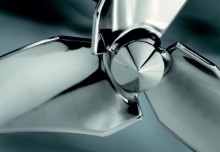Agitator retrofit boosts dairy energy efficiency
Agitator retrofit boosts dairy energy efficiency
German dairy Milchwerke Oberfranken West eG installed a new 360,000-litre tank to boost production of its cheese making milk. Using the Alfa Laval ALS Agitator proved to be a very cost-efficient strategy.

The dairy planned to increase its cheese production. After three months of testing, the results were so convincing that the company decided to retrofit 11 conventional propeller agitators with 11-15 kw of power with Alfa Laval ALS agitators with EnSaFoil propellers.
Milchwerke Oberfranken West eG is one of the leading international producers of fine cheese specialties. Located in Germany’s Coburg District, the company produces approximately 37,500 tons of a broad assortment of quality soft, hard or processed cheese preserved solely with table salt.
To increase production of its natural cheese products produced by using microbiological rennet for fermentation of raw milk, the dairy installed a new 360,000-litre tank. Intrigued by the prospect of cost savings offered by a more energy-efficient agitator, the dairy decided to follow the recommendations of long-time business supplier and an Alfa Laval channel partner, Euroflow. To test the agitator for energy efficiency, hygiene and food safety, Milchwerke Oberfranken West installed the Alfa Laval ALS Agitator that uses only 4 kW of installed power instead of installing a conventional tank agitator with 18 kW of installed power.
Same high-quality hygienic production
The dairy began testing the agitator with a volume of 100,000 litres of milk in its newly installed tank. The volume was steadily increased to 150,000 litres, and then to full tank capacity of 360,000 litres. Samples were taken every hour to check the quality of the milk. “The milk ingredients, especially the fat content, were checked. We detected no changes in the production line for cheese and the manufacture of the product,” says Dieter Stuerzl, quality manager for equipment, Milchwerke Oberfranken West eG. “Furthermore, we let the standardized non-homogenized milk stay in the tank for a day to see whether there were differences in the processing of raw milk using the new agitator,” Stuerzl continues. “The test agitator worked smoothly during the entire process, thereby meeting our expectations.”
The test agitator worked smoothly during the entire process, thereby meeting our expectations.”
After the three-month trial period for the Alfa Laval ALS Agitator, the Milchwerke Oberfranken West ordered 11 new energy-efficient agitators to replace the conventional tank agitators being used.
Retrofitting 11-15 kW agitators with 2.2-kW agitators According to Stuerzl, there must be convincing reasons for replacing conventional agitators with new ones. One of the most important reasons for a dairy to retrofit existing equipment is to achieve considerable energy savings. “If there are existing agitators running in the production process, it is often hard to imagine a restructuring,” Stuerzl confides. “Given a 220,000-litre milk tank and an 11-15 kW agitator, retrofitting to a 2.2 kW agitator is an enormous undertaking. Naturally, we are also happy to see the associated energy savings.”
We are also happy to see the associated energy savings.”
Up to 80% in energy savings
The Alfa Laval ALS agitators feature specially designed rotor blades that require less energy input than conventional agitators. Reductions of up to 80% in energy consumption can be realized, which promotes environmental protection and provides substantial greenhouse gas emissions reductions. “The innovative propeller design yields an unusually high pumping capacity but at the same time uses far less energy than conventional agitators,” says Marcus Schmid, owner of Euroflow. “Moreover, the agitator blades displace the milk with very low shear stress, which may otherwise negatively affect the fat globule membranes at higher levels of shear stress.” Another plus: Alfa Laval agitators can be customized to the exact needs of the plant and installed from the top, bottom or side, as is the case for Milchwerke Oberfranken.

Looking ahead
Stuerzl says that the success of the agitator retrofit project has reinforced Milchwerke Oberfranken West’s decision to carry out further energy-saving projects in the dairy. “I believe that the flow behaviour and the gentle handling of the milk by the Alfa Laval ALS Agitator has had a positive effect on the product,” he confides. “But, surely, one must also put some heart and idealism into the manufacture of products and pay attention to the entire process. I think there is still a lot of potential in technical system innovations and dairy managers should not turn a blind eye to this.” He points to retrofitting large dairy pumps with more energy efficient pumps as holding potential for energy savings as well. In some cases, the electrical rating of dairy pumps and motors can be reduced from 15 kW to 11 kW given the same hydraulic power.
“Product quality and technical innovations in a dairy operation are not mutually exclusive but rather complement each other,” he says, “There is no progress without innovations”.
- Clean-label yoghurt: what you need to know 25/11/2020
- Tetra Pak research study reveals food safety-environment dilemma fostered by COVID-19 pandemic 17/11/2020
- Alfa Laval SRU Pump – a proven curd transfer solution 30/06/2021
- GlaxoSmithKline tanks clean profit 25/11/2020
- Alfa Laval LKH pumps reduce energy costs, downtime and emissions 25/11/2020
- Tetra Pak accelerates action towards reduced littering and sustainable future 29/03/2021



